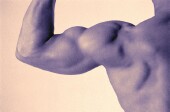 |
 |
 |
||
    |
||||
|
||||

Genes May Help Drive Rotator Cuff Injury
The risk is higher if even distant relatives have suffered such problems, study finds|
|
HealthDay
Wednesday, February 25, 2009
 WEDNESDAY, Feb. 25 (HealthDay News) -- Genes may boost the odds of developing rotator cuff problems, according to new research that finds the shoulder injury running in families.
WEDNESDAY, Feb. 25 (HealthDay News) -- Genes may boost the odds of developing rotator cuff problems, according to new research that finds the shoulder injury running in families.
The finding is based on an analysis of health data on more than two million Utah residents. It showed that rotator cuff trouble among even distant relations, such as third cousins, can predict an individual's risk.
"Rotator cuff tears are very common," said study lead author Dr. Robert Tashjian, a shoulder and elbow surgeon as well as an assistant professor in the department of orthopaedics at the University of Utah School of Medicine in Salt Lake City. "It's the number one problem that an orthopaedic surgeon treats in terms of shoulder issues in the clinic. And yet, no one really knows exactly why they occur."
"In fact, we know a lot of people in their seventies and eighties never develop rotator cuff injuries, even though very often they engage in the same activities as people who do develop rotator cuff tears," he said. "And by the same token, many people who get the tears are actually not very active."
Based on those observations, the team speculated that "maybe some people are predisposed to developing tears for some reason," Tashjian said. "And when we looked at the information in a very extensive state-wide database, we found that there was a hereditary contribution to rotator cuff problems that extends all the way out to third-degree relatives."
Tashjian and colleague Lisa Cannon-Albright were expected to discuss the findings this week at the annual meeting of the American Academy of Orthopaedic Surgeons (AAOS), in Las Vegas.
According to the AAOS, the rotator cuff enables the arm to lift and rotate by holding in place the top part of the upper arm bone (humerus) through a network of muscles and tendons.
While rotator cuff tears can strike anyone following a traumatic injury, most develop among men and women over the age 40 after years of repetitive stress or overuse take their toll on the relevant muscles. Weakness and/or pain when lowering or lifting the arm could be a sign of a tear, the AAOS warns.
Rotator cuff trouble may be especially problematic for the disabled, according to a second study also expected to be presented at the AAOS meeting. Researchers led by Dr. Michael Akbar of the University of Heidelberg, Germany, found evidence of rotator cuff injury in almost half of wheelchair-bound paraplegic patients, with the risk of such injuries rising 5 percent for each year of wheelchair dependency.
In the study by Tashjian and Cannon-Albright, the researchers sifted through the Utah Population Database (UPD), which pairs health data with genealogical records concerning millions of Utah residents.
"The people who grow up in Utah tend to stay here," Tashjian noted, and the data "often contains information on three, four, or even five generations of any one family."
The study authors found that the risk for developing rotator cuff disease was "significantly elevated" among men and women related to rotator cuff patients by first or second degree.
In particular, for those under the age of 40, a "significantly elevated" risk existed if relatives, even very distant ones, had experienced a rotator cuff injury.
This all points to a genetic predisposition to rotator cuff problems, the researchers said.
"A lot of things could contribute to the onset of rotator cuff disease, but I think this shows that patients are probably predisposed or not predisposed to developing it," Tashjian said. "And at some point in the future, if we could isolate a gene or combination of genes that account for this predisposition, maybe those people who have it can engage in certain exercises or take certain precautions to prevent a future rotator cuff tear. Or perhaps we could even figure out how to reverse the affects of this dysfunctional gene."
Dr. Ken Yamaguchi, a professor of orthopaedic surgery at Washington University in St. Louis, believes the study provides "extremely important information."
"The prevalence of rotator cuff disease is incredibly large," he noted. "It's a huge public health problem in the U.S., given that by the age of 65, about 50 percent of the population actually has rotator cuff injuries, even if most don't know it because they don't hurt or have profound weakness or any symptoms. So understanding why it happens is fundamental to perhaps figuring out how to intervene."
"And all of our research so far," Yamaguchi added, "has shown that rotator cuff disease is much more of an age-related process. That it is not related so much to injury, but is part of a much more gradual and degenerative process that for some reason affects some, but not others. So here it's hard to argue with what this study shows. It's very convincing data."
HealthDay
Copyright (c) 2009 ScoutNews, LLC. All rights reserved.
Related News:
More News on this Date
Related MedlinePlus Pages:
| Home | Health Topics | Drugs & Supplements | Encyclopedia | Dictionary | News | Directories | Other Resources | |
| Disclaimers | Copyright | Privacy | Accessibility | Quality Guidelines U.S. National Library of Medicine, 8600 Rockville Pike, Bethesda, MD 20894 National Institutes of Health | Department of Health & Human Services |
Date last updated: 26 February 2009 |
